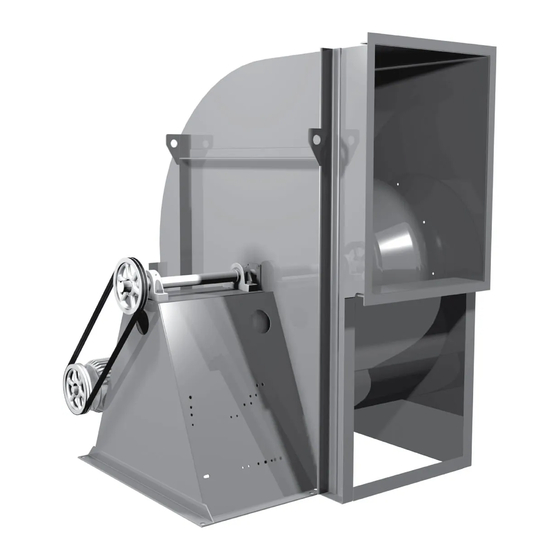COOK CF SWSI Manual de instalação, operação e manutenção - Página 4
Procurar online ou descarregar pdf Manual de instalação, operação e manutenção para Ventilador COOK CF SWSI. COOK CF SWSI 17 páginas. Centrifugal blowers
Também para COOK CF SWSI: Manual de instalação, operação e manutenção (12 páginas)

Wiring Installation
NOTICE! All wiring should be in accordance with
local ordinances and the National Electrical
Code, NFPA 70. Ensure the power supply
(voltage, frequency, and current carrying
capacity of wires) is in accordance with the
motor nameplate.
(See page 5 for diagram)
Leave enough slack in the wiring to allow for motor
movement when adjusting belt tension. Some fractional
motors have to be removed in order to make the connection
with the terminal box at the end of the motor. To remove
motor, remove bolts securing motor base to power
assembly. Do not remove motor mounting bolts.
Units with Arrangement 10 have a hole provided at the
base of the bearing pedestal to accommodate wiring.
Follow the wiring diagram in the disconnect switch and
the wiring diagram provided with the motor. Correctly label
the circuit on the main power box and always identify a
closed switch to promote safety (i.e., red tape over a closed
switch).
Backward Inclined
Airfoil
Wheel Rotation
Test the fan to ensure the rotation of the wheel is the
same as indicated by the arrow marked Rotation.
For 115 and 230 Single Phase Motors: Fan wheel
rotation is set correctly at the factory. Changing the rotation
of this type of motor should only be attempted by a qualified
electrician.
For 208, 230, and 460, 3 Phase Motors: These motors
are electrically reversible by switching two of the supply
leads. For this reason, the rotation of the fan cannot be
restricted to one direction at the factory. See Wiring
Diagrams above for specific information on reversing wheel
direction.
NOTICE! Do not allow the fan to run in the wrong
direction. This will overheat the motor and cause
serious damage. For 3-phase motors, if the fan is
running in the wrong direction, check the control
switch. It is possible to interchange two leads at this
location so that the fan is operating in the correct
direction.
Belt and Pulley Installation (belt drive)
Belt tension is determined by the sound the belts make
when the fan is first started. Belts will produce a loud squeal
which dissipates after the fan is operating at full capacity. If
the belt tension is too tight or too loose, lost efficiency and
possible damage can occur.
Do not change the pulley pitch diameter to change
tension. This will result in a different fan speed than desired.
1. Loosen motor adjustment nuts on and move motor in
order that the belts can easily slip into the grooves on
the pulleys. Never pry, roll, or force the belts over the
2. Slide the motor back until proper tension is reached.
3. Lock the motor adjustment nuts in place.
4. Ensure pulleys are properly aligned. Refer to Figure 4.
Up thru 12"
12" up through 48
Pulley Alignment (belt drive)
Pulley alignment is adjusted by
Forward Curved
loosening the motor pulley setscrew and
by moving the motor pulley on the motor
shaft.
Figure 4 indicates where to measure
the
alignment tolerance. All contact points
(indicated by WXYZ) are to have a gap
less than the tolerance shown in the
table. When the pulleys are not the
same width, the allowable gap must be adjusted by half of
the difference in width (As shown in A & B of Figure 4).
Figure 5 illustrates using a carpenter's square to adjust the
position of the motor pulley until the belt is parallel to the
longer leg of the square.
Final Installation Steps
1. Inspect fasteners and setscrews, particularly fan
2. Inspect for correct voltage with voltmeter.
3. Ensure all accessories are installed.
Recommended Torque for Setscrews & Hold Down Bolts
Size
No.10
1/4"
5/16"
3/8"
7/16"
1/2"
5/8"
3/4"
4
rim of the pulley.
For proper tension a deflection of approximately 1/4"
per foot of center distance should be obtained by firmly
pressing the belt.
OFFSET
Tolerance
A
Center
Maximum
W
Distance
Gap
1/16"
1/8"
Over 48"
1/4"
X
Y
Figure 4
Z
B
allowable
gap
for
mounting and bearing fasteners, and tighten according
to the recommended torque shown in the following
table.
Setscrews
Recommended
Key
Torque
Hex
(inch/lbs)
Across
Flats
Min.
Max.
3/32"
28
33
1/8"
66
80
5/32"
126
156
3/16"
228
275
7/32"
348
384
1/4"
504
600
5/16"
1104
1200
3/8"
1440
1800
ANGULAR
OFFSET/ANGULAR
CENTER
DISTANCE
(CD)
GAP
the
drive
Figure 5
Hold Down Bolts
Wrench Torque
Size
(inch/lbs)
3/8"-16
240
1/2"-13
600
5/8"-11
1200
3/4"-10
2100
7/8"- 9
2040
1"- 8
3000
1-1/8" - 7
4200
1-1/4" - 7
6000
GAP
